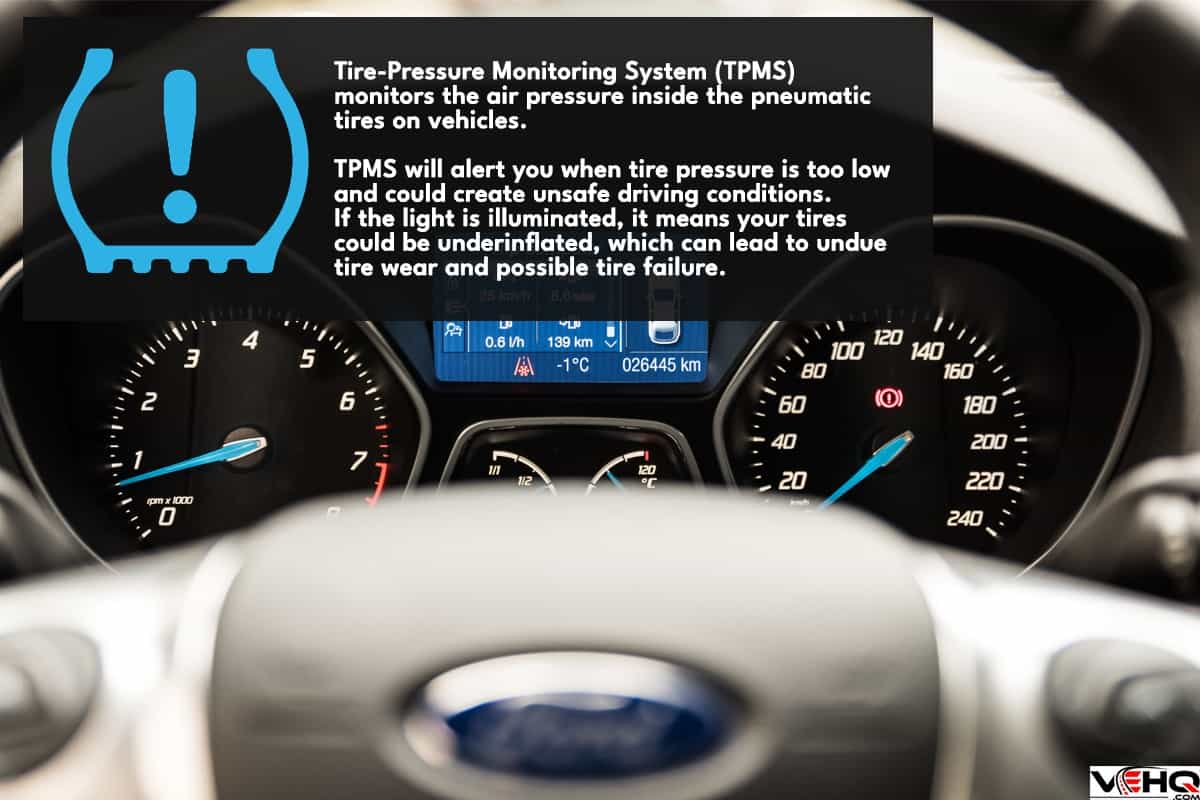When the TPMS (tire pressure monitoring system) on your Ford's dashboard flashes a warning sign and your tire pressure is fine, you have a tire pressure sensor fault.
You'll need to reset it to work properly, and we've researched this process. Here's how to reset the Ford tire pressure sensor:
- Push the brake pedal down with your foot, wait three seconds, then take your foot off the brake.
- Turn the start button on and off three times. If the ignition requires a key, switch the ignition to On with the key. Do not start the engine.
- End with the On mode on the third push. You will hear a beep after each on-off push.
- Repeat steps 1–3.
- You'll see a "Train Left Front Tire" message on your dashboard. That sign tells you that the training of the tires has begun.
- The training will move clockwise from the left front tire to the right front tire, to the right rear tire, and to the left rear tire.
- When done, push the start button again and two beeps will follow. If you don't hear any beeps, repeat the process.
This method works on 2011–2021 Ford vehicles. You should not reset your TPMS in an area where radio frequency is present. The wavelengths will interfere with your readings.
There are other ways to reset the Ford tire pressure sensor. In this post, we include ways to reset a tire pressure sensor fault specific to other Ford vehicles. Keep reading to learn more about these issues.
Is It Safe To Drive With A Tire Pressure Sensor Fault?

A tire pressure sensor fault may be caused by one or more of your car's tires having too much or too little pressure.
If you persist in driving when you have over- or underinflated tires, you are putting yourself, your passengers, and other cars in danger.
Tires with low air pressure can lead to a crash from a tire blowout. Lack of air can cause the sidewalls to flex; a bigger surface of the tires will rub against the road, causing friction and heat.
Too much heat will result in a portion of the tire's rubber separating from the tire. Under these conditions, you may have a tire blowout, especially if driving at a higher speed on the interstate.
A tire pressure sensor fault may also mean overinflated tires, which are just as bad.
Be sure to check out: Types Of Ford Cars [Excluding Trucks]
Like a bloated balloon, tires with too much pressure can explode if they hit a pothole or a sharp rock. You could panic, lose control of the wheel, and crash.
If you get a tire pressure sensor fault, always assume your tires have low or too much air pressure before anything else. Check the pressure on all your tires with a tire gauge.
Do this when the tires are cold, which is three hours after it was last driven, or first thing in the morning.
Release air from the tires if they are over-inflated. Check while releasing air until the tire reaches the desired psi.
Add air using an air pump until you get the tire's recommended psi for tires with too little pressure.
You might also like: Where Are Tire Pressure Sensors Located?
Aside from air pressure, a tire pressure sensor fault happens when the batteries run out of power, or the metal valve stems are corroded.
If it's dead batteries or a corroded valve stem, the recommendation is to change the TPMS with a new one.
Sometimes, the sensor warning results from a lost connection, like if you have driven over a bump or a pothole.
You can also get a sensor warning signal if you replaced your tires and the new ones are not connected to the system.

How To Reset The Ford Tire Pressure Sensor
You can reset a Ford tire pressure sensor with these techniques:
- Drive around at 50 mph for 10 minutes. Then turn the car off and wait 20 minutes.
- Push the start button without running the engine. Press the tire pressure sensor button and keep your finger on it until the fault message blinks three times. Release your finger from the button and start the engine.
- Inflate all tires to 3 psi above the recommended level. Then deflate them to near zero. After deflating, inflate all tires to the recommended psi.
Learn more: Does Heat Affect A Tire Pressure Sensor?
Ford Fusion Tire Pressure Sensor Fault
The Ford Fusion (2006–2012) is a midsized sedan with a 2.0L or 2.3L engine. It is a higher-end car with premium features and a roomy interior.
If you get a tire pressure sensor fault icon or message, you can reset it after checking that the tire pressures are of the recommended psi.

Here's how to reset a Ford Fusion TPMS with ">key ignition for models 2006 to 2012:
Put the car sensors in train mode. Put the key in the ignition, push hard on the brake with your foot, and release it.
Turn the key to the On position and turn it off. Do this three times, with the third time ending in the On mode.
Push the brake pedal again and release it. Turn the key On-Off three times. On the third time, end with it in the On position.
Learn more: How Long Does a Ford Fusion Last? [in Mileage and Years]
You'll hear three beeps indicating that the tires are now in the train setting, and this message will appear on the dashboard: "Train Left Front Tire."
Get out of the car and use a diagnostic tool or scanner to train each tire separately.
Check out this TPMS Sensor Tool on Amazon.
First, set up the tool by choosing the car maker (Ford,) the model (Fusion), and the year. Choose "Manual Relearn" to train each tire.
Press the scan button and hold the scanner near the sensor. Press start. When the horn honks, the tire is now trained. Press Ok.
Repeat the process on all four tires. The dashboard will then flash the message "Training Complete."
For more details, watch the video below:
 Ford Focus Tire Pressure Sensor Fault
Ford Focus Tire Pressure Sensor Fault

Ford Focus third-generation models (2012—2019 in the U.S.) have manufacturer-installed tires with a 35 psi measurement on all four tires. To reset its tire pressure sensor fault, here's what you do:
Using an air pump, inflate all tires to 40–45 psi level, then go to the driver's seat of your Ford Focus.
Push the start button once without putting your foot on the brake pedal. (For key ignition, turn the key once and don't run the engine.)
Then hit the hazard light button quickly six times. The car will beep, and you'll see this sign on your dashboard: "Train Left Front Tire."
You might also like: How Much Weight Can A Ford Focus Carry?
Get out of the car and deflate the left front tire first.
To do this, remove the cap on the valve stem and, using a screwdriver, push down on the metal pin located in the middle of the valve until you hear two honks. Stop pressing and replace the cap.
Repeat this process on the rest of the tires going clockwise: right front tire, right rear tire, left rear tire. You'll hear a honk after each tire deflation.
Get back inside the car and turn it off. The tire pressure sensor fault sign should be gone when you turn it on again.
Get this digital tire pressure gauge on Amazon.
Ford Edge Tire Pressure Sensor Fault

The Ford Edge is a crossover SUV that entered the market in 2007 and is now in its second generation model. It is available in both gasoline and diesel models.
Resetting the tire pressure sensor fault of the Edge is similar to other Ford vehicles:
Start by inflating all tires to their recommended psi measurement. Then press the brake pedal and release.
Switch the ignition on and off three times, ending the third time in the On position.
Press the brake again and then release it.
Switch the ignition on and off three times, ending the third time in the On mode.
The horn will honk once, and you'll see the message "Train Left Front Tire" on the dashboard. This means that train mode has begun.
You might also like: Which is Bigger: Ford Edge or Escape?
Get out of the car and use a diagnostic tool to scan all tires, one at a time, clockwise (left front tire, right front tire, right rear tire, left rear tire.)
The horn will honk once to signal a successful train following each scan. The message "Training Mode Complete" will appear on the dashboard.
Turn off the ignition.
Check out this portable air pump on Amazon.
Ford Mustang Tire Pressure Sensor Fault

Ford's longest-running car is the iconic Mustang.
Its variants range from the modest Ecoboost engine to the mighty GT. If your Mustang hasn't been moved or driven for a while, its TPMS may go to sleep mode and show a tire pressure sensor fault message.
Related: What Ford Mustang Has The Most Horsepower?
Here's what a Ford expert did to wake it up and train it:
Disconnect the negative battery cable and wait for ten minutes, then press down on the brake and release it.
You should then hit the start button—make sure it is in the On position; your TPMS on the dashboard will have no sensor data.
Start up the car and drive. After two minutes, the rear wheels should reset and show a 33 reading. After ten minutes, the front tires should reset and show 32 and 34 psi, respectively.
The next time you turn on the car, the TPMS should not show a fault message again. Don't drive for a long period with your negative battery cables disconnected and don't forget to reconnect the cable after resetting.
For details on the process, watch this video:
In Closing
The TPMS is designed to provide real-time information on the tire condition of your car. Its primary purpose is to prevent accidents by alerting you of deviations from the norm.
A tire pressure sensor fault will show up on your Ford's dashboard if the tires are underinflated or for other reasons. Always look for the cause and reset until the TPMS is working again.



